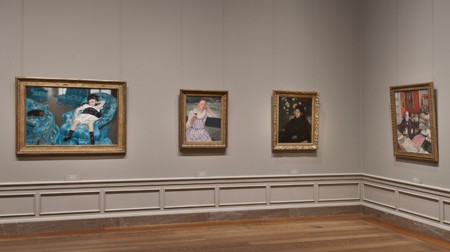Early studies on Mary Cassatt (1844–1926) were rife with speculation on the nature of her relationship with Edgar Degas (1834–1917), whereas more recently scholars writing about Cassatt have deliberately avoided such discussions. At the same time, studies on Degas have generally devoted little attention to his relationship with Cassatt. Thus, although there is extensive scholarship on both artists, most of it is devoted to one or the other. The fullest of the rare comparative studies is the catalog for the exhibition Degas / Cassatt at the National Gallery of Art (2014), edited by curator Kimberly A. Jones, who made a deliberate choice to focus strictly on the works themselves. The essays in the catalog shed new light on Degas’s and Cassatt’s affinities in style, subject matter, technique, and media—all within the framework of artistic reciprocity.
My book project extends such scholarship by focusing on both the work and its context: on both ”textual” and “extratextual” issues that have shaped the Degas-Cassatt relationship and its representations. In particular, it offers the first extensive comparative study of the two artists that centers on the intertwined issues of historiography, gender, and legacy. Comparing the construction of the legacies of Cassatt and Degas, it will analyze historiography and exhibition history, canonization processes and shifts in the canon, attributions of cultural significance and value in art history, and differing French and American priorities in museum exhibitions and permanent displays.
Preliminary research has convinced me that the representation of the relationship between Degas and Cassatt has been constructed according to an asymmetric paradigm. This emerged clearly from a comparative study of their extensive involvement in art collecting: I found that the tangible significance and impact of their respective collecting activities, judged from a historical perspective, has played almost no role in the shaping of their legacies or even in the assignment of cultural value to their collecting interests in particular. Cassatt’s extensive work with American collectors, particularly Louisine and Henry O. Havemeyer, resulted in the most important American collection of works by Gustave Courbet, Édouard Manet, Edgar Degas, and other impressionists. Bequeathed to the Metropolitan Museum of Art in 1929, the Havemeyer collection transformed the museum’s standing in representing modern art. Yet Cassatt’s achievements in collecting, and in particular her influence on the Met, have been greatly undervalued. Degas’s collection, by contrast, has always been highly esteemed in art-historical scholarship even though it did not survive and thus has had limited historical influence. (The collection was dispersed upon his death in several sales that drew much press coverage and critical attention in 1918.) The asymmetric paradigm becomes conspicuous in the gap between the impact of Degas’s and Cassatt’s practices, on the one hand, and their respective resonance in art criticism and art-historical scholarship, on the other. An analysis of these issues appears in my essay “The Collecting Practices of Degas and Cassatt: Gender and the Construction of Value in Art History,” in Perspectives on Degas (Routledge, 2016), a revised version of which will be a chapter in the book that results from this research project.
My residency at CASVA provided ideal conditions for research, with the great resources of the National Gallery of Art Library and its superb interlibrary loan staff, the proximity of the Library of Congress and the Archives of American Art, and the welcoming context of CASVA, including the opportunity for stimulating conversations with fellow scholars and National Gallery curators. Being at CASVA also provided an ideal opportunity to study the display of Cassatt’s paintings in the Gallery’s permanent collection. Cassatt is particularly well represented, with several major paintings on view in the galleries devoted to French impressionism, where her work is set in the context of paintings by her French colleagues, including Degas.
The brief but intense and highly rewarding period at CASVA was crucial to my project. It was entirely dedicated to assembling research materials, many of which would otherwise not have been accessible. The wealth of materials collected will form the nucleus of the next phase of my work on the project.
